|
Sailing on the Plastic Seas
Students Travel to Great North Pacific Garbage Patch in Search of Trash
Ioana Patringenaru | September 28, 2009
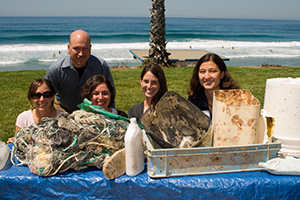
Graduate students from the Scripps Institution of Oceanography pose with some of the debris they collected in the Great Pacific Garbage Patch.
Click here to learn more about the voyage to the Great Pacific Garbage Patch.
When a group of graduate students at UCSD’s Scripps Institution of Oceanography put together a trip to an area known as the Great North Pacific Garbage Patch this summer, they wondered what they would do if they didn’t find any garbage. They spent a fair amount of time coming up with contingency plans, just in case they came up empty-handed. They needn’t have worried.
During their 20-day trip, students found plastic everywhere. They fished out everything from small specks, to fishing nets, to toys. The trip to the North Pacific allowed them to gather a treasure trove of data about how much garbage truly is out there and how it affects marine organisms. They are now working in their labs at Scripps to figure out what the data show.
Their cruise was extensively covered by major media outlets, including The New York Times, the Associated Press and several TV networks, and helped publicize the problem of plastic pollution in the world’s oceans.
“This is a very simple problem to understand,” said Tony Haymet, director of UCSD's Scripps Institution of Oceanography. “The problem is us. And we think we can take a run at it.”
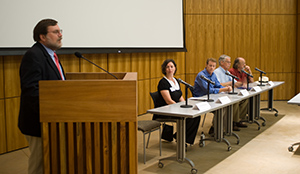
Scripps Director Tony Haymet talks about the Seaplex expedition during a press conference.
The cruise was so successful that Scripps officials are now working to raise funds for a trip to the South Pacific garbage patch sometime within the next two years, Haymet announced at a press conference in August. That project’s scope is far greater. While the North Pacific patch is roughly the size of Texas, its South Pacific cousin is about four times as large—roughly the size of all of Western Europe.
The cruise to the North Pacific patch came about when seven Scripps graduate students decided to take part in a UC-wide competition that funds cruises designed and led by students, and other projects. They submitted a proposal to investigate plastic debris in the North Pacific. Miriam Goldstein, who became the cruise’s chief scientist, and six of her classmates, got the idea from a talk on marine conservation given at Scripps by Marcus Eriksen, of the Algalita Marine Research Foundation.
“We realized it’s such a huge problem,” Goldstein said. “Here we are at Scripps, where we have all these resources, and ocean exploration is what we do.”
The Scripps students won the competition, which funded some of their time aboard a Scripps ship, the Research Vessel New Horizon. In addition, Scripps partnered with Project Kaisei, an organization dedicated to studying the garbage patch and cleaning it up. “We want to help revive our most precious resource, the ocean,” said Doug Woodring, one of the Project Kaisei leaders.
Life on board
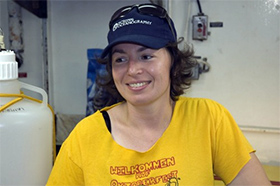
SEAPLEX Chief Scientist Miriam Goldstein.
Ship time is hard to come by—and expensive. So, the students were determined to make the most of it. Once they reached the area where they would collect samples, they worked 12-hour shifts, guaranteeing that research would take place on the boat around the clock. Graduate students, and Project Kaisei volunteers, used nets of different shapes and sizes to collect samples of different sizes at various depths. Nets went in the water every couple of hours.
The results were remarkably consistent. The researchers cast their nets in the ocean more than 100 times over 1,700 miles. Each time, they found plastic. “For a scientist, that’s really shocking,” Goldstein said. “It’s pretty unusual to find what you are looking for over and over again.”
Often, students didn’t catch up on sleep for a few days, as they helped their classmates working on the next 12-hour shift. Some nets needed three to four people to deploy. Samples needed to be classified and preserved.
Pollution shock
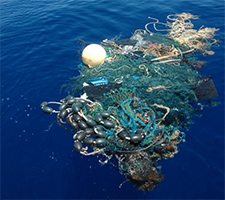
SEAPLEX researchers encountered a large net with tangled rope, net, plastic and various marine organisms attached to it.
On slower days, students remember enjoying great food prepared by the New Horizon crew, including sushi and birthday cakes. They could also watch movies or lounge on the deck and watch as birds, fish and other sea creatures went by. At night, they admired strange creatures coming up from the deep to feed and bioluminescence lighting up the waves. One student recalls seeing a manta ray gliding by in the night.
Many students also recall specific moments when the reality of the pollution hit them. For Goldstein, it happened on a warm, sunny day. She and colleagues took out a small boat to take a closer look at the ocean. At first glance, it looked pristine. But as Goldstein peered at the surface, she realized that small specks of plastic were floating everywhere. Under the specks were small, fragile, marine organisms.
“It was a really poignant comparison between animals below and human impact above,” she said.
For her colleague Meg Rippy, the revelation happened at the start of one of her day shifts. Albatross were flying around the ship. One landed on a piece of plastic floating nearby. It was the first time Rippy had seen an albatross. To see it in conjunction with that piece of plastic was particularly shocking, she recalled. But oftentimes, plastic pollution is more subtle, Goldstein said. The vast majority of debris researchers observed was small, she added.
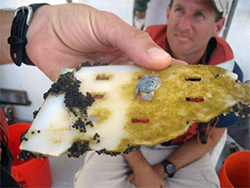
A piece of plastic grating, with a pelagic crab, algae, and masses of
flying fish eggs. This piece was floating at the surface and collected with a dip net off the side of the New Horizon.
“There’s no island, there’s no eighth continent,” she said. “It doesn’t look like a garbage dump. It looks like beautiful ocean. But then when you put the nets in the water, you see all the little pieces.”
When students flew back home, they checked in some of the debris at the airport—appropriately secured in garbage bags. To their surprise, airlines didn’t object. “We made it,” said Chelsea Rochman, a Scripps graduate student. “They didn’t say anything.”
The garbage patch
Currents and winds lead plastic adrift on the ocean to spots known as gyres and where everything slows down and debris accumulate. The North Pacific patch, or gyre, is located about 1,000 miles off the California coast.
How does plastic get in the ocean in the first place? About 90 to 95 percent of the world’s global plastic production doesn’t get recycled, said Woodring, from Project Kaisei. To do our part and keep all that plastic out of the ocean, we must recycle and reuse, he said. It’s also important to buy products that use recycled components. Plastic debris is pervasive not only in the ocean, but also all over the Pacific Rim, Scripps Professor Peter Niiler said. Many big population centers in other parts of the world don’t have good garbage disposal systems.
“Everything goes downstream,” Woodring said. “And downstream is the ocean.”
What’s next?
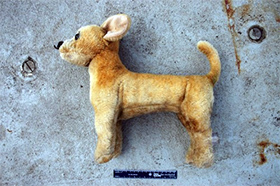
A stuffed dog, nicknamed Lucky by the SEAPLEX researchers, was found in a net. (Photo / Jim Leichter)
In the coming months, Goldstein and her fellow graduate students will try to find out how much plastic is clogging the oceans and how it affects marine life. Goldstein is looking at the distribution and abundance of plastic debris. She’s also trying to see if the debris helps invasive species thrive. “There’s stuff growing on that plastic and it’s floating around,” she said.
Pete Davison, a fifth-year doctoral student, is looking at how fish that migrate from the depths to the surface are affected when ingesting plastic. Rochman is investigating how pollutants that leech from the plastic affect organisms that might ingest them. Rippy studies the effects of plastic debris on bacterial community compositions.
In 2010 and 2011, Scripps researchers will try to find answers to some of these questions in the South Pacific Garbage Patch too. The patch is 3,600 nautical miles away, said Scripps Professor Niiler. That’s 26 days of sailing.
“It’s time to go there,” Scripps Director Haymet said. “But we’re going to need a bigger boat.”

|